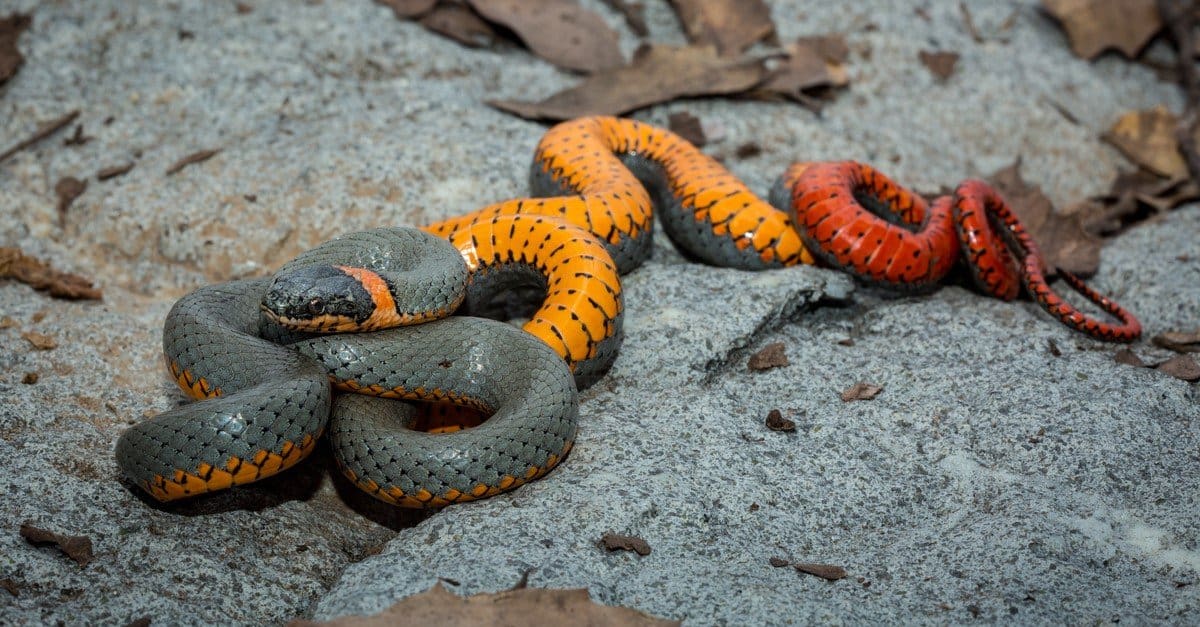Ringneck snakes (Diadophis punctatus) are small, harmless snakes found in North America. These snakes are typically between 10 and 15 inches long, and they are gray or brown in color with a yellow or orange ring around their neck that matches their colorful belly.
Ringnecks are a popular choice for people who want to have a pet snake, but they are not necessarily recommended for beginners. This is because they can be very delicate, and they require special care in order to stay healthy.
What Do Ringneck Snakes Eat?
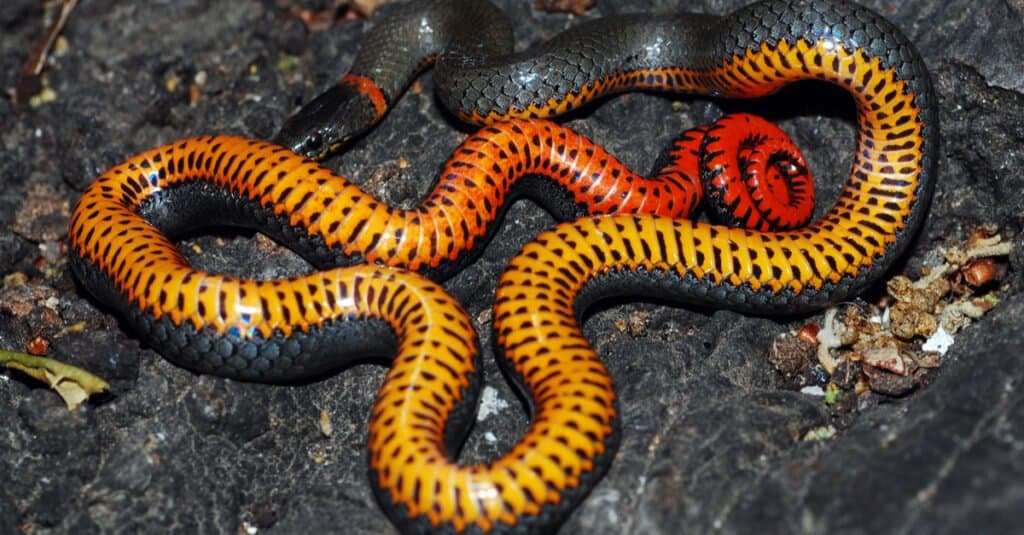
Ringneck snakes can only eat small prey that can be easily overpowered and digested such as earthworms, slugs, salamanders, and crickets.
©Jason Mintzer/Shutterstock.com
Ringneck snakes eat a variety of small prey, including earthworms, slugs, and salamanders. As carnivorous predators, they will also eat other small snakes, reptiles, and amphibians that they come across in the wild.
As pets, ringneck snakes are typically fed worms, crickets, and slugs, 2-4 times per week. To avoid malnutrition, you should dust their food with a calcium and vitamin supplement powder before feeding.
A Complete List of Foods Ringneck Snakes Eat
Ringneck snakes eat:
- earthworms
- mealworms
- salamanders
- newts
- skinks
- slugs
- crickets
- small lizards
- frogs
- toads
- small fish
- juvenile snakes of other species
The diet of each individual ringneck snake will depend on where they live and what prey animals are available to them in their environment. Since they are relatively small in size, they will only eat small prey items that they can easily overpower and digest.
How Do I Feed My Pet Ringneck Snake?
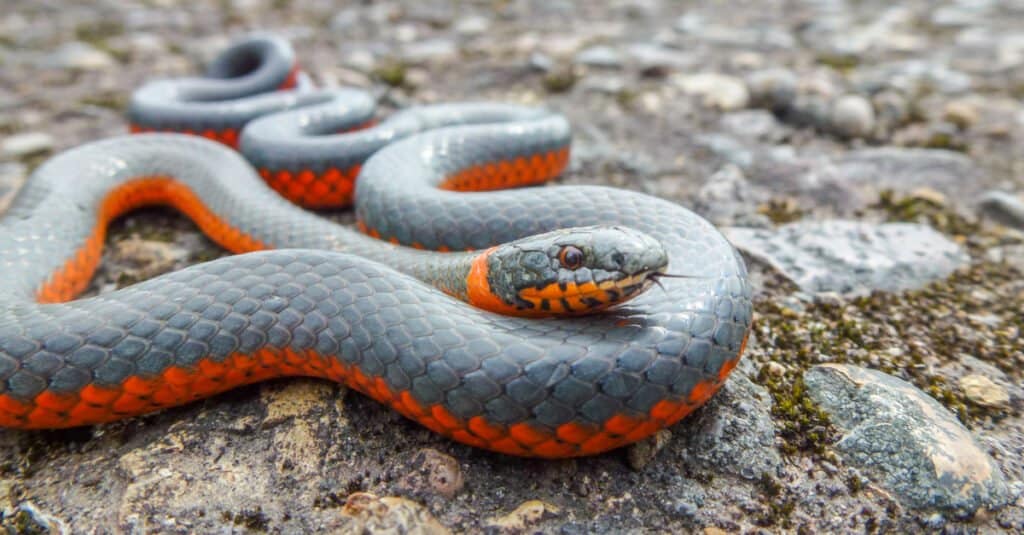
Pet ringneck snakes are fed worms and crickets, 2-4 times per week.
©Tom Fenske/Shutterstock.com
Pet ringneck snakes are generally fed 2-4 times per week. Usually, these meals take the form of worms and crickets. Since pet ringnecks typically receive a significantly less varied diet than their wild counterparts, it is important to dust their food with a vitamin and mineral supplement powder before each feeding. This will help to ensure that your snake stays healthy and does not become malnourished.
Although many people generally think that snakes eat mice, ringnecks appear to have an aversion to eating mice and other mammals. Because of the ringneck’s small size, it may be more likely that a rat will eat it, rather than it eating the rat. For this reason, ringneck snakes can be great for people who want a pet snake but wouldn’t feel good about feeding live mice to their pet.
What Do Baby Ringneck Snakes Eat?
Baby ringneck snakes may go up to two weeks without eating after they hatch. Since they were getting plenty of nutrients from inside the egg, they don’t need to eat right away.
Once they’re ready to start eating on their own, baby ringneck snakes will start to eat small insects and worms. As they begin growing, they’ll need to sustain themselves with more frequent meals than adults do, every other day, as opposed to 2-4 times each week.
Where Do Ringneck Snakes Live?
Ringneck snakes are woodland reptiles found throughout North America, primarily in the temperate climate zones of the United States and Eastern Canada.
They prefer areas with lots of hiding and denning locations, such as:
- deciduous forests
- rocky hillsides
- meadows
- grassy fields
- gravel pits
- garbage dumps
- gardens
- barns
They tend to hide under the cover of leaves, bark, rocks, brush, logs, and other debris. Ringneck snakes may also use abandoned dens or burrows of other animals, hollow stumps, and man-made structures such as storm drains or culverts as dens.
Are Ringneck Snakes Venomous or Dangerous?
Ringneck snakes are only slightly venomous and are not considered dangerous to humans. Not only are they small and generally non-aggressive, but their rear-facing fangs are at the back of their mouth, making them very unlikely to injure you.
If they do try to bite you, it probably won’t hurt and might not even penetrate your skin. However, do keep in mind that all animal bites are capable of carrying and spreading bacteria that can cause infection. Wash any ringneck snake bites thoroughly with soap and water, and seek medical attention if you develop signs of an infection.
How Do Ringneck Snakes Hunt and Catch Their Prey?
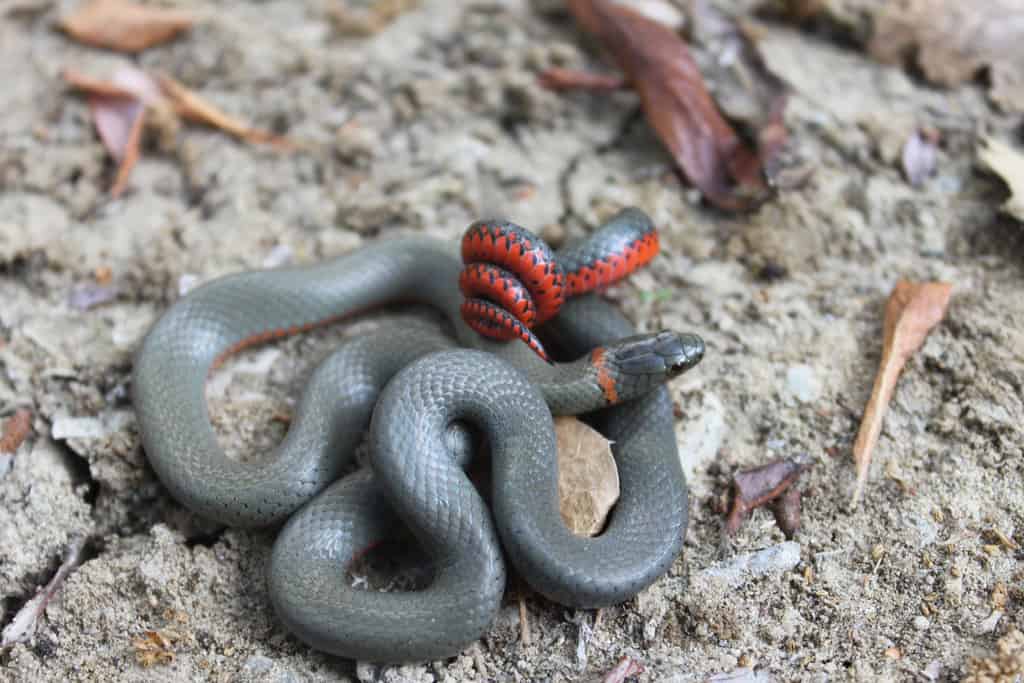
Ringneck snakes strike quickly, then coil around their prey before killing and swallowing them whole.
Ringneck snakes are nocturnal hunters that use their keen sense of smell to find prey. They are very secretive, and they spend most of their time hidden away in dens or burrows during the day.
At night, they will come out to hunt for food. Once they have located their prey, the ringneck will strike quickly and constrict their prey by coiling their body around it and squeezing tightly. Their mild venom helps to subdue their prey and makes it easier for them to kill and swallow whole.
What Eats Ringneck Snakes?
Ringneck snakes are eaten by a variety of larger predators, including:
- bigger snakes (coral snakes, king snakes, racers)
- screech owls
- domestic cats
- shrews
- armadillos
- skunks
- wild hogs
- possums
- ferrets
- raccoons
- rats
- bullfrogs
- kingfisher birds
- red-tailed hawks
When ringnecks are young and small, they may even be eaten by centipedes and large spiders.
How Do Ringneck Snakes Defend Themselves?
Ringneck snakes are not poisonous, meaning that other animals can safely eat them without being harmed. However, when threatened, their primary defensive maneuver involves tricking potential predators into thinking they are poisonous.
They do this by coiling up their body like a corkscrew and exhibiting their brightly colored belly, which is usually yellow or orange. This vibrant display may resemble the warning colorations of other poisonous animals, such as some types of frogs and insects. The predator may then believe that the ringneck is similarly poisonous or foul-tasting and choose to avoid it.
If this bluff doesn’t work, ringnecks may also try to fight back or bite their attacker, but since these often cause just a minor wound on large predators, they are often unsuccessful.
Do Ringneck Snakes Hibernate?
Reptiles don’t hibernate the same way as mammals. Instead, they brumate.
During brumation, reptiles slow their activity to conserve energy. They sometimes emerge on warmer winter days to bask and get a drink of water. However, they don’t eat. Many ringneck snakes brumate together in communal dens. These dens can be in rotten logs, under rocks, in old stone walls, in other animals’ burrows, or in various other hidden locations.
During this period, their body temperature is too low for them to be able to digest their food properly. This means they have to fatten themselves up in the season leading up to winter in order to have enough energy stores to last them until spring. On the occasional warmer days, they may emerge from their dens to get some food and water, but generally, they stay hidden away, conserving their energy until the weather warms up again.
Are Ringneck Snakes Good To Have Around?
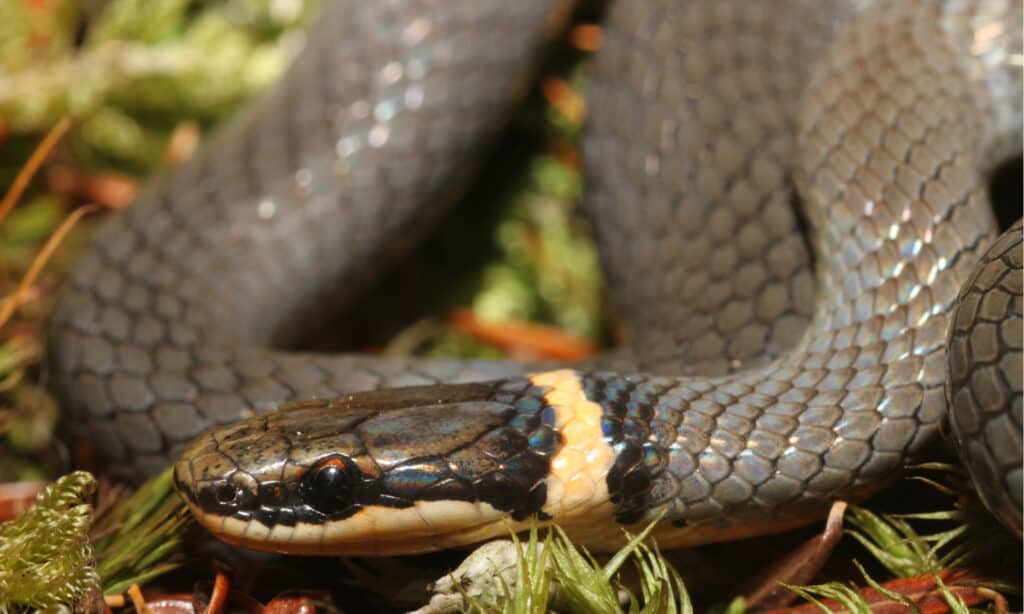
If you find a ringneck snake in your yard, there is no need to kill it.
©/Shutterstock.com
Ringneck snakes provide a valuable service by eating harmful pests, such as slugs, snails, and insects. They also play an important ecological role by contributing to the biodegradation of leaves, sticks, and other organic matter. As they maneuver over and through this debris, they help to break down this organic matter and recycle those nutrients back into the soil.
If you find a ringneck snake in your yard, there is no need to kill it. It is not a threat to you—it will probably slither away and hide from you if it can. On the rare occasion when they might have accidentally made their way into your basement or barn, you can gently relocate them outside without harming them.
Are Ringneck Snakes Endangered?
Ringneck snakes are generally not considered endangered. However, there is one subspecies that is listed as “state-threatened” as opposed to “federally threatened or endangered.” This subspecies is the Key ringneck snake, native to the Florida Keys.
Due to the clearing of their pine rockland habitat, as well as predation by invasive species, getting hit by cars, flooding, and rising sea levels, their populations have been in decline. Although not currently federally protected, the Key ringneck snake is afforded some protections under Florida state law.
These guidelines forbid taking, possessing, selling, harassing, harming, pursuing, hunting, shooting, wounding, killing, trapping, capturing, or collecting Key ringneck snakes in Florida.
But for all the other varieties of ringneck snakes in other parts of the country, they are given the endangerment label of “least concern.”
How Can You Snake-Proof Your Property?
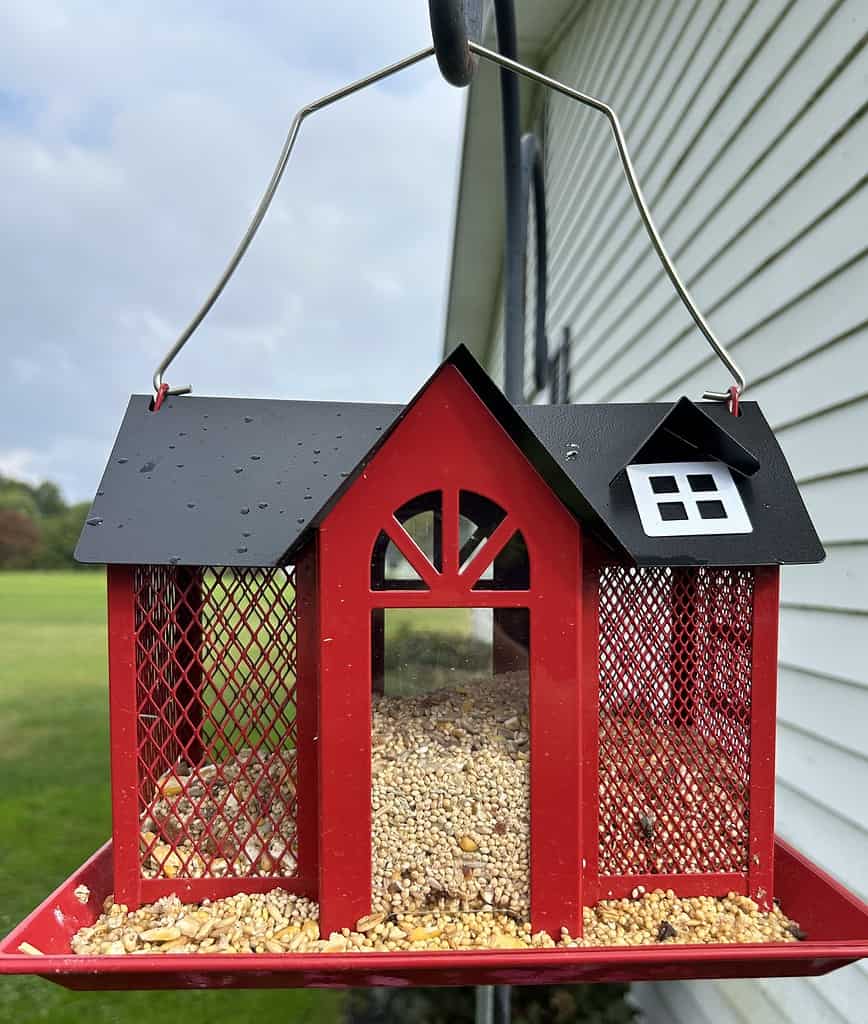
Birdfeeders are a fun way to attract wild birds, but don’t be surprised if snakes follow suit.
While the ringneck snake is among those considered to be harmless to humans, that still doesn’t change the fact that some folks just don’t want snakes slithering around on their property! Here are some helpful tips to keep snakes away.
- Rid your yard of potential reptile shelters–any places where snakes can find shelter are attractive to them because they like to hide. Places they could hide would be leaf piles, wood piles, in empty containers like buckets or flower pots, or around large rocks. Checking for and removing these hiding places can discourage snakes.
- Lawn upkeep–Stay on top of mowing your lawn, as snakes can be attracted to tall, overgrown grass and brush.
- Rid your yard of any standing water–Standing water is a definite draw to snakes, whether it be ponds, bird baths, fountains, or puddles.
- Eliminate food sources for snakes–Snakes like to prey on rodents and birds, as well as other small mammals. If you have birdfeeders to attract wild birds, you could also be inviting snakes into the yard. Make sure to actively curtail rodents on your premises as well, as they also attract snakes.
- Have outdoor pets that scare away snakes–Dogs and cats are often enemies of snakes, as well as some kinds of chickens, so these are potential options for keeping snakes away.
Discover the "Monster" Snake 5X Bigger than an Anaconda
Every day A-Z Animals sends out some of the most incredible facts in the world from our free newsletter. Want to discover the 10 most beautiful snakes in the world, a "snake island" where you're never more than 3 feet from danger, or a "monster" snake 5X larger than an anaconda? Then sign up right now and you'll start receiving our daily newsletter absolutely free.
Thank you for reading! Have some feedback for us? Contact the AZ Animals editorial team.

